-

人教版高中英语必修4Body Language说课稿4篇
Textbook: Senior English for China (Book 4), by Liu Daoyi Time Allotment: 1 period (40 minutes)Date: March 20, 2014Teaching aids: blackboard, Multi-media, Power Point, chalk I. Text Analysis (教材分析)This unit is about body language, and the text selected in the reading part demonstrates the difference and similarity of body language in many parts of the world. Through learning this passage, students are required to raise their awareness of using body language in different parts of the world. As body language is closely related to our daily life, it is easy to arouse students’ interest in learning this text. Reading skills and speaking training are designed around the text.II. Teaching Objectives (教学目标)By the end of the lesson, students will be able to:1. Language Skill Objective(语言技能目标): develop reading ability (skimming and scanning)as well as speaking ability.2. Cultural Knowledge Objective(文化知识目标): know about the cultural differences of using body language.3. Affective Objective(情感目标): increase students’ awareness of using body language correctly in different cultures. III.Teaching Focuses and Difficulties(教学重点和难点)1. Teaching Focuses(教学重点): the difference and similarity of body language in many parts of the world.2. Teaching Difficulties(教学难点): develop students’ reading abilities of skimming and scanning and ask the students to show their opinions with fluent English.

人教版高中英语必修1Anne's best friend说课稿
Step 7 Language points 1.Vocabulary (1) go through (2) set down (3) a series of (4) on purpose (5) in order to (6)at dusk (7)entirely (8)face to face 2.Important sentences (1)…I’ve grown so crazy about everything to do with nature. (2)There was a time when … (3)I stayed awake on purpose until … (4)It was the first time … that I’d seen the night … (5)It’s no pleasure looking through … Purpose: 1.Master the required vocabulary and sentence structures. 2.Use them freely. Step 8 Consolidation 1.Find out the topic sentences 2.Retell the text according to the topic sentences Purpose: I want to know if my students understand the text. Step 9 Discussion Imagine you have to go into hiding like Anne and her family, what would you miss most? Giveyour reasons. Purpose: Train Ss’ oral English ability. Step 10 Homework Write an article on Friends. Purpose: 1. Improve the Ss’ writing ability. 2 Train the Ss’ ability of self—teaching and looking up information by themselves. Part 5 Blackboard design(说板书设计)Unit 1 Friendship Reading Anne’s Best Friend 1.Main idea of each paragraph: Para. 1 Anne made her diary her best friend. Para .2 Anne wrote her feelings in her diary. Para .3 Anne missed nature. Para.4 Anne saw the night face to face Para.5 Anne wanted to experience nature outdoors. 2.Listening: Exx.1 P3 3.Discussion: Exx.3 P3 Purpose: 1.Make Ss familiar with the passage 2.Make the design inductive, instructive and artistic.

人教版高中英语必修1English around the world说课稿
(3)v. 给:提出;展现,显现present sb. with sth. ; present sth. to sb. 把. . 交给;颁发;授予present sth. (for sth. )/present sth. to sb. e. g. Om his birthday, his friends presented him a collection of stamps. 在他生日时,他的朋友们送给他一套邮票作为礼物。The sword was presented by the family to the museum. 这家人把宝剑捐赠给了博物馆。The committee will present the final report to Parliament in June. 委员会将在六月向议会提交最后的报告。You need to present yourself better. 你需要更善于展现自己。It is essential that we present a united front. 至关重要的是我们要表现得更加团结。Step 4 ConsolidationT:Now that we have got a general idea of these words and phrases. Lets make up some sentences using them to master them. Suggested sentences:1. Your duties include typing letters and answering the telephone. 2. It is one of the greatest roles that she has played. 3. A large number of people have applied for the job. 4. The number of the panda is declining. 5. I'11 go there, even if I have to walk. 6. He came up to me to ask for a light. 7. The novel is about a family who can't communicate with each other. 8. He based his plan on interests of most people. 9. Why doesn't he make use of his singing talent?Step 5 Summary and homeworkT:Today we dealt with several new words and phrases. After class I hope that youcan read them again and again to keep them in mind. That's all for today. You aredismissed.

人教版高中英语必修2Wildlife Protection说课稿3篇
When it comes to the students’ studying methods, I'd like to introduce my Ss first. The Ss have a good command of basic language points. They’re interested in learning English, and they take an active part in English class, so they will have fun in autonomous, cooperative and inquiry learning. I will just serve as a guide, showing them the way to explore how to make more progress in their English learning.Now it’s time for the most important stage of this lesson. My teaching procedures are arranged as follows:Step1.Leading-in (3 minute)Play a video of a wide variety of wildlife to introduce my topic. Step2. Speaking (12 minutes)We will use our textbook Page25. Let the Ss fast read the short paragraph to warm up. Ask them to talk about the report on some endangered wildlife in China with the dialogue patterns on the screen. Lastly, I will invite some groups to demonstrate their dialogues about saving wildlife in China.Step3.English play (3 minutes)Watch another video in praise of their excellent performance just now. It’s about Jack Chen’s(成龙)and Yang Ziqiong’s wildlife protection.Step4. Listening (twice 13 minutes)This time, I’ll ask the Ss to fill in the blanks of the monologue of the 2 movie stars above. Step5.Discussion (3 minutes)Which would you like to choose to wear, clothes made of cotton, artificial leather or animal skins? Why ?Step6. Summary (3 minutes)1. If there were no wildlife, there wouldn’t exist human beings. If the buying stops, the killing can, too.2. Animals are our friends. To love animals is to love ourselves. Stop hunting, killing and destroying wildlife.3. Let’s live in harmony with all the living things in the world. Step7. Music appreciation (3 minutes)Let the Ss appreciate the song Earth Song by Michael Jackson. Last but not the least, I will show you my blackboard design.

人教版高中英语必修4A taste of English Humor说课稿3篇
Then I would ask them to think of a funny English or Chinese and tell it to partners. While telling stories, they can use expressions and some acting to help make the story funny. 5 minutes would be given to do this.Those stories they told there will be the material for their writing. Soletting them tell it at first is helpful. And they can make a difference between telling a funny story and writing it down. Generally speaking, it is difficult forstudents to write well because they don’t know what to write and how to write. Asking them to tell their own stories at first can help them come up with what to write.After their telling, I would invite someone to share his/her story with all of us and I would write it down on the blackboard.This example story would be used as a sample to illustrate the format of funny story. Different from a story from teacher or textbook, a story from students can obviously become a interesting material to draw students’ attention.Then I would ask the whole class to put this story into several parts. It might be a little bit difficult for them. So I would ask them to find out whether all the sentences are necessary. After delete some sentences, there are 6 sentences left behind. Then they can easily put them into three parts. After interaction with students, I would teach them the right terms for each part and conclude the format of funny story.This step is the key and difficult point in my lesson. So I mainly usetask-based teaching method in this part and the task for students was divided into several stages. With the separated difficult level, students can find there are usually three parts in writing. They can also learn to write without the unnecessary parts in the process of analyzing. And then I wouldn’t rush to tell them the right terms to them directly. Instead, I would ask them to name them by their own. A confused mind is better for acquiring knowledge.While-writing:Then I would give students 7 minutes to write down this story, without other requirements.With all the preparations in pre-writing, students’ difficulties were cleared. So it would be much easier for them to write down the story within 7 minutes. There are no other requirements because students’ first writing is actually a drafting. It would be revise and edit several times later. Writing, as a skill

人教版高中英语必修4Women of achievement说课稿4篇
Good morning, distinguished judges:It’s my honor to talk about my teaching ideas with you. Today my topic is Women of Achievement. My presentation consists of six parts: the analysis of teaching material and student, teaching aims, key and difficult points, teaching and studying method, teaching procedures and blackboard design.First, let’s focus on the analysis of teaching material. This lesson is from New Senior English for China Student’s Book 4 Unit 1, the reading part. The main topic of the passage is the introduction of a student of Africanwildlife. After this lesson, the students will learn more information about her studying chimps in Africa, and their reading and speaking abilities can be developed as well.The next part is the analysis of students. My students are in senior high students. They have learnt English for many years, they’ve known many words and sentences, but their speaking and reading abilities are still not very good. So I will practice their speaking and reading abilities through different exercises.According to the New Standard Curriculum and the present situation, I set the teaching aims as follows: firstly, knowledge aims. Students can grasp some new words, such as worthwhile, move off. Moreover, students can understand the content of the passage and get familiar with the topic of studying chimps in wildlife. Secondly, ability aims. Students can use reading strategies such as skimming and scanning in reading process. Thirdly, emotional aims. Students can have the awareness of protecting animals and care about animals.Based on the above analysis, the key point of this lesson is to get the main idea and the detailed information from the passage; the difficult point is to talk about the wildlife protection and use reading strategies.

人教版高中英语必修3The million pound bank note说课稿3篇
在接下来的细读环节,我套用了高考对阅读理解的考查方式设置了5个问题,分别为三个推理判断题,一个细节题和一个主旨大意题。学生需要对文章的内容进行分析、归纳、推理、猜测等高级思维活动才能做出正确的回答。【设计意图】这一过程是对学生进行细读的训练,培养学生获取特定信息和挖掘文章深层次信息的能力。第三环节:Intensive-reading (精读) 15′第三个环节精读,既是最重要的环节,也是突破本课重难点的关键。首先,让学生思考剧本中人物看到百万英镑前后的态度发生了怎样的变化。其次,让学生仔细阅读文章,找出可以表现人物态度变化的具体的语言和动作。最后,让学生总结人物的态度发生变化的根本原因是什么,从而引出Money Talks, 供学生思考。【设计意图】通过一系列的活动培养学生学习从人物的语言和动作探究人物的心理,使学生进一步体会戏剧语言的魅力,从而对文章背后所反映的社会问题进行思考,也为下一步的讨论环节做好铺垫。

人教版高中英语必修5First aid说课稿6篇
In this class, I have 3 teaching aims, that is, knowledge aims, ability aims and emotion aims.1) Knowledge-Teach students new words and expressions, such as temporary, bleed,sprain choke, first aid, fall ill and so on.-Enable students to have a better understanding for some basic knowledge of first aid.2) Ability-Train students’ speaking, reading and writing abilities by different teaching activities, such as skimming, comprehending, team work, role play, retelling and writing.-Develop students’ reading strategy on how to move general idea to specific information.3) Emotion-Promote students’ awareness of giving first aid.- Cultivate students’ creativities.Then let’s come to my teaching methods and activities.III. Teaching methods and activities:To achieve different teaching aims, various kinds of teaching methods and activities will be adopted throughout this period, such as TBL (task-based learning), skimming, team work, brainstorm and others, which can offer students opportunities to fulfill tasks in which they can use language to achieve a specific outcome.IV. Teaching aids:Computer and blackboardV. Teaching important points:1) Make students have a clear mind for the structure of the text.2) Help students understand the theme of the text.VI. Teaching difficulties:1) So many new words may affect students’ understanding.2) How to get students to know about the functions of the skin and thecauses, characteristics and treatments for different degree burns,and the knowledge about giving first aid. VII. Blackboard design:

人教版高中英语必修5Life in the Future说课稿5篇
Good afternoon, everyone. It’s my great pleasure to be here sharing my lesson with you. The content of my lesson is Senior English for China Book5 Unit 3 Life in the Future. I’ll be ready to begin this lesson from six parts: Analysis of the teaching material, Analysis of the students, Teaching aims and important and difficult points, Teaching methods and aids, Teaching procedures, and Blackboard design. First, let me talk about the teaching material.Part 1 Analysis of the Teaching Material:This unit is about what human beings’ life will be like in about one thousand years. By studying of this unit, we’ll Enable the students to know the changes in humans’ life and some new inventions bringing about the change and develop the interest in science. This lesson plays an important part in the English teaching in this unit. This is an important lesson in Book Five. From this lesson, it starts asking the Ss to grasp contents of each passage. Therefore, this lesson is in the important position of the teaching material. If the Ss can learn it well, it will be helpful to make the Ss learn the rest of this unit.Part 2 Analysis of the SsAs Senior2 Ss, they are at different levels of English fluency, some of them have lost interest in English. So during the lesson, I arrange a variety of activities to let all of them join in to attract their interest and let them be confident and taste the joy of success.

人教版高中地理必修2煤城焦作出路何在说课稿
分析过焦作市的地理概况和产业优势后,就需要针对由于资源枯竭所带来的问题提出合理化的建议。既然是谈经济转型,就应该将话题的范围明确在这一领域内。通过材料3的相关内容,我们了解到焦作市需要在产业结构调整、培育新的优势产业、增强综合竞争力等三个整改方针上下功夫。因而引导学生针对优势与不足提出建议,以三个整改方针为基准,衡量建议的可行性是锻炼学生解决此类问题的有效途径。在此我将教会学生的是解决问题方法而非案例的内容,正所谓“授之以鱼,不如授之以渔”。接下来针对学生的建议和教材资料分析所罗列的10点整改思路,由学生自由发言提出看法,通过教师的指导和学生的讨论,进而确定经济转型建议的具体方案。最后注意将建议与产业优势相对照,看建议是否都是围绕着产业优势而提出的,这样做会加深学生的印象,通过建议和优势的对应关系,将不难找出此类问题的解题思路。
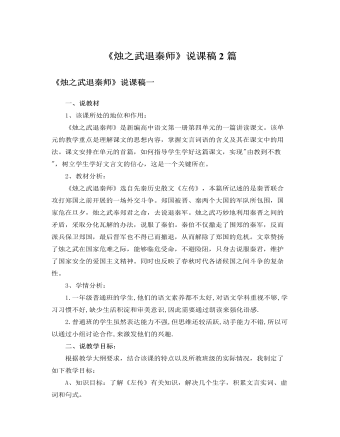
人教版高中语文必修1《烛之武退秦师》说课稿2篇
4、本文的重点是说辞,虽仅百余字,却委婉曲折,步步进逼,层层深入,表现出高超的劝说艺术、游说技巧。让学生细细品味并概括说辞中包含几层意思。第一层(“秦、晋围郑,郑既知亡矣”),分析形势,以退为进,博得好感。第二层(“若亡郑而有益于君”至“君之薄也”),亡郑陪邻,动摇联盟。第三层(“若舍郑以为东道主”至“君亦无所害”),存郑有益,利益引诱。第四层(“且君尝为晋君赐矣”至“唯君图之”),追溯历史,深入离间。可见烛之武面对大国的君主,巧舌如簧,不卑不亢,从容辞令,既不刺激对方也不失本国尊严,语言的分寸掌握得恰到好处。表现出烛之武机智善辩的外交才能。5、面对风云突变的局势,晋侯没有感情用事,而表现了清醒的头脑和理智的判断。这种隐忍不发、随机应变的胸怀和谋略,正是晋文公终成霸业的根本原因。设计意图:本环节的重点是全面把握烛之武这一人物性格特征,以及退秦师过程中体现出的非凡的胆识以及高超的谋略和语言艺术。
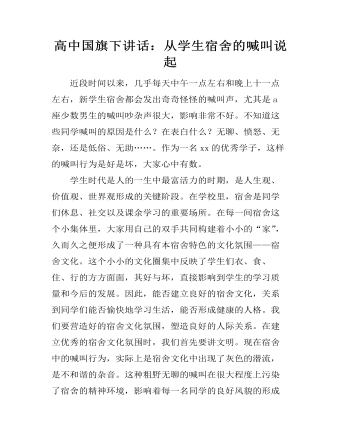
高中国旗下讲话:从学生宿舍的喊叫说起
近段时间以来,几乎每天中午一点左右和晚上十一点左右,新学生宿舍都会发出奇奇怪怪的喊叫声,尤其是a座少数男生的喊叫吵杂声很大,影响非常不好。不知道这些同学喊叫的原因是什么?在表白什么?无聊、愤怒、无奈,还是低俗、无助……。作为一名xx的优秀学子,这样的喊叫行为是好是坏,大家心中有数。学生时代是人的一生中最富活力的时期,是人生观、价值观、世界观形成的关键阶段。在学校里,宿舍是同学们休息、社交以及课余学习的重要场所。在每一间宿舍这个小集体里,大家用自己的双手共同构建着小小的“家”,久而久之便形成了一种具有本宿舍特色的文化氛围——宿舍文化。这个小小的文化圈集中反映了学生们衣、食、住、行的方方面面,其好与坏,直接影响到学生的学习质量和今后的发展。因此,能否建立良好的宿舍文化,关系到同学们能否愉快地学习生活,能否形成健康的人格。我们要营造好的宿舍文化氛围,塑造良好的人际关系。在建立优秀的宿舍文化氛围时,我们首先要讲文明。现在宿舍中的喊叫行为,实际上是宿舍文化中出现了灰色的潜流,是不和谐的杂音。
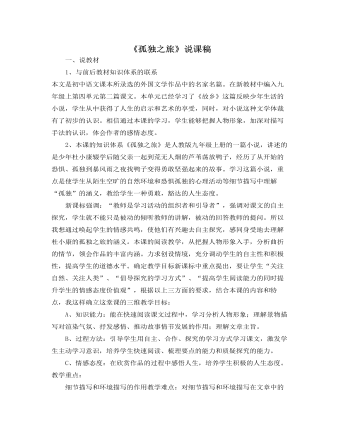
部编版语文九年级上册《孤独之旅》说课稿
二、说教法:我在设计这节课时努力实践新课程理念,充分突出学生的主体地位选择教学方法,整堂课以“在情节与现实写照中得到情感体验”为教学主线,通过整体感知,情节领悟,细节品味等途径,运用快速阅读,自主合作探究等方法,引导学生深入文本,感受主旨,与文章对话,与自己对话,与同学老师对话,在这种感受,体验、交流的课堂学习过程中逐步提升情感态度价值观。三、说学法:采用“自主、合作、探究”的学习方式,让学生自主进入文本,读出感受,通过小组合作交流探究来解决问题。【二·三理论依据】教学过程必须根据学生语文学习的特点,关注学生的个体的学习需求,爱护学生的好奇心,求知欲,充分激发学生的主动意识,倡导自主、合作、探究的学习方式,有助于学生学习方式的形成。
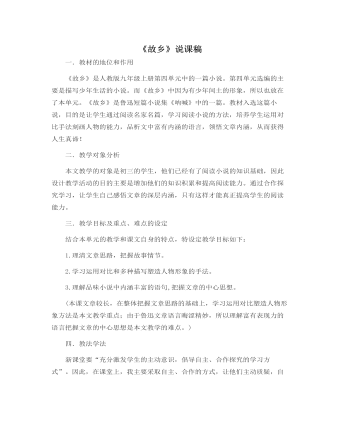
部编版语文九年级上册《故乡》说课稿
一.教材的地位和作用《故乡》是人教版九年级上册第四单元中的一篇小说。第四单元选编的主要是描写少年生活的小说。而《故乡》中因为有少年闰土的形象,所以也放在了本单元。《故乡》是鲁迅短篇小说集《呐喊》中的一篇。教材入选这篇小说,目的是让学生通过阅读名家名篇,学习阅读小说的方法,培养学生运用对比手法刻画人物的能力,品析文中富有内涵的语言,领悟文章内涵,从而获得人生真谛!二.教学对象分析本文教学的对象是初三的学生,他们已经有了阅读小说的知识基础,因此设计教学活动的目的主要是增加他们的知识积累和提高阅读能力。通过合作探究学习,让学生自己感悟文章的深层内涵,只有这样才能真正提高学生的阅读能力。三.教学目标及重点、难点的设定

部编版语文九年级上册《醉翁亭记》说课稿
1.创设情景法:利用多媒体课件,音乐、图片、文字相结合,激发学生学习兴趣和对本课的求知欲望,从而达到良好的教学效果。2.“自学——点拨——归纳”法:课前,教师根据教学目标设计出本课的“自学问题单”,让学生结合“自学问题单”先自学,预习课文;课堂上,小组合作讨论、解疑,教师适时点拨,最后归纳,逐步解决“自学问题单”中的问题,从而完成“教学目标”中的任务。四、说学法郭沫若先生曾说读书要“用自己的头脑来想,用自己的眼睛来看,用自己的手来做”。《语文课程标准》也特别强调:语文课程必须面向全体学生,使学生获得基本的语文素养,自主、合作、探究的学习方式应得到积极的提倡。九年级学生经过两年的初中学习后,已基本形成了一定的学习方法,也已经有了自主意识和自主学习的能力,所以,我采用了“自主、合作、探究”的学习方式。
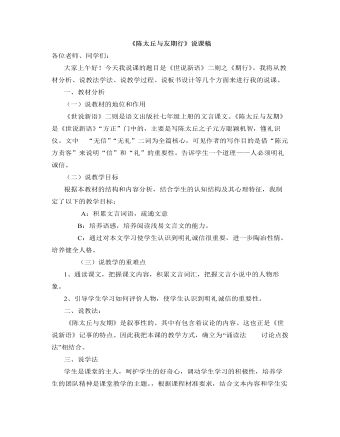
部编版语文七年级上册《陈太丘与友期行》说课稿
各位老师、同学们:大家上午好!今天我说课的题目是《世说新语》二则之《期行》。我将从教材分析、说教法学法、说教学过程、说板书设计等几个方面来进行我的说课。一、教材分析(一)说教材的地位和作用《世说新语》二则是语文出版社七年级上册的文言课文。《陈太丘与友期》是《世说新语》“方正”门中的,主要是写陈太丘之子元方聪颖机智,懂礼识仪。文中 “无信”“无礼”二词为全篇核心,可见作者的写作目的是借“陈元方责客”来说明“信”和“礼”的重要性。告诉学生一个道理——人必须明礼诚信。(二)说教学目标根据本教材的结构和内容分析,结合学生的认知结构及其心理特征,我制定了以下的教学目标:A:积累文言词语,疏通文意B:培养语感,培养阅读浅易文言文的能力。
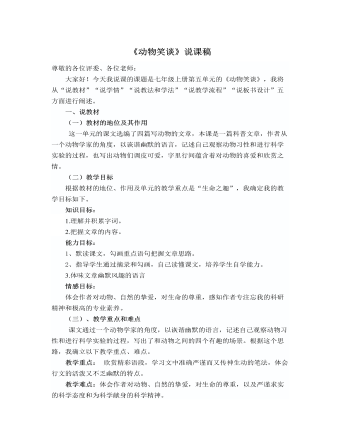
部编版语文七年级上册《动物笑谈》说课稿
(一)谈话激趣,导入新课好的开头是成功的一半,注重导入情节的创设,是兴趣激发的一个重点,也是创设学习氛围的重要环节。因此在导入新课时,我会用富有感染力的话语吸引学生,激发学生的学习兴趣。具体设计:同学们,在我们的地球上生活着大量的动物,走进它们,我们会发现世界是那么的多姿多彩,富有情趣。在这一点上,法国的法布尔做得很好,与他一样负有盛名的是奥地利的动物学家康拉德?劳伦兹,他曾经获得诺贝尔生理医学奖,今天就让我们走进他的《动物笑谈》,去看看他和动物之间有趣的故事吧!(二)初读课文,整体感知学生在预习的基础上将重点字音及成语解释在书上进行勾画和补充,进一步熟悉课文,并概括文章的主要内容。1.关于作者康拉德?劳伦兹(1903 -1989+,奥地利动物行为学家,1973年由于对动物行为学研究方面开拓性的成就而获诺贝尔生理医学奖,除了在学术上的成就之外,劳伦兹最为人所称道的是他在动物行为方面的通俗写作,著有《所罗门王的指环》《攻击的秘密》《雁语者》《狗的家世》等。
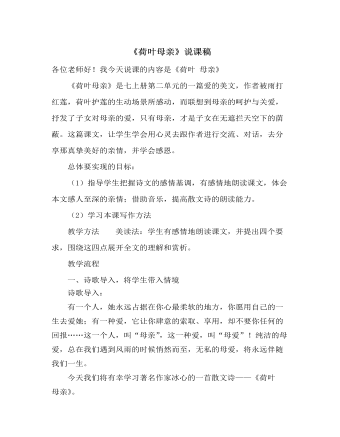
部编版语文七年级上册《荷叶·母亲》说课稿
各位老师好!我今天说课的内容是《荷叶 母亲》 《荷叶母亲》是七上册第二单元的一篇爱的美文,作者被雨打红莲,荷叶护莲的生动场景所感动,而联想到母亲的呵护与关爱,抒发了子女对母亲的爱,只有母亲,才是子女在无遮拦天空下的荫蔽。这篇课文,让学生学会用心灵去跟作者进行交流、对话,去分享那真挚美好的亲情,并学会感恩。总体要实现的目标: (1)指导学生把握诗文的感情基调,有感情地朗读课文,体会本文感人至深的亲情;借助音乐,提高散文诗的朗读能力。(2)学习本课写作方法教学方法 美读法:学生有感情地朗读课文,并提出四个要求,围绕这四点展开全文的理解和赏析。
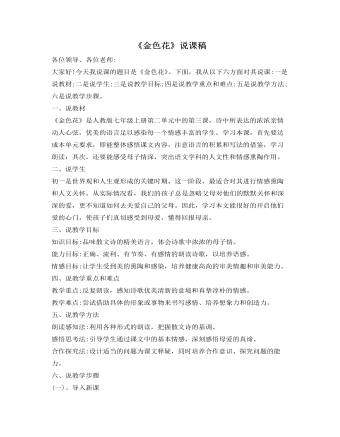
部编版语文七年级上册《金色花》说课稿
三、说教学目标知识目标:品味散文诗的精美语言,体会诗歌中浓浓的母子情。能力目标:正确、流利、有节奏、有感情的朗读诗歌,以培养语感。情感目标:让学生受到美的熏陶和感染,培养健康高尚的审美情趣和审美能力。四、说教学重点和难点教学重点:反复朗读,感知诗歌优美清新的意境和真挚淳朴的情感。教学难点:尝试借助具体的形象或事物来书写感情、培养想象力和创造力。五、说教学方法朗读感知法:利用各种形式的朗读,把握散文诗的基调。感悟思考法:引导学生通过课文中的基本情感,深刻感悟母爱的真谛。合作探究法:设计适当的问题为课文释疑,同时培养合作意识、探究问题的能力。六、说教学步骤(一)、导入新课课前播放满文军的《懂你》,音乐结束后,老师简洁引入:“有一种爱,一生一世不求回报,母爱;有一个人,一生一世值得我们去爱,母亲。今天,让我们走进泰戈尔的散文诗《金色花》,去感受那份纯洁的永恒的母爱吧!”
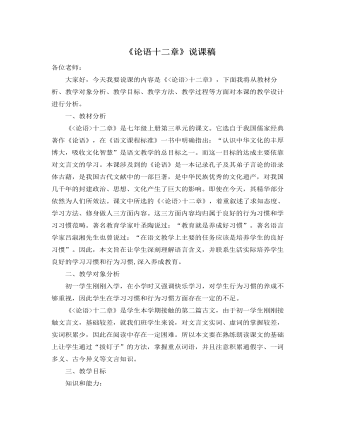
部编版语文七年级上册《论语》十二章 说课稿
一、教材分析《十二章》是七年级上册第三单元的课文。它选自于我国儒家经典著作《论语》,在《语文课程标准》一书中明确指出:“认识中华文化的丰厚博大,吸收文化智慧”是语文教学的总目标之一。而这一目标的达成主要依靠对文言文的学习。本课涉及到的《论语》是一本记录孔子及其弟子言论的语录体古藉,是我国古代文献中的一部巨著,是中华民族优秀的文化遗产,对我国几千年的封建政治、思想、文化产生了巨大的影响。即使在今天,其精华部分依然为人们所效法。课文中所选的《十二章》,着重叙述了求知态度、学习方法、修身做人三方面内容。这三方面内容均归属于良好的行为习惯和学习习惯范畴。著名教育学家叶圣陶说过:“教育就是养成好习惯”。著名语言学家吕淑湘先生也曾说过:“在语文教学上主要的任务应该是培养学生的良好习惯”。因此,本文旨在让学生深刻理解语言含义,并联系生活实际培养学生良好的学习习惯和行为习惯,深入养成教育。

